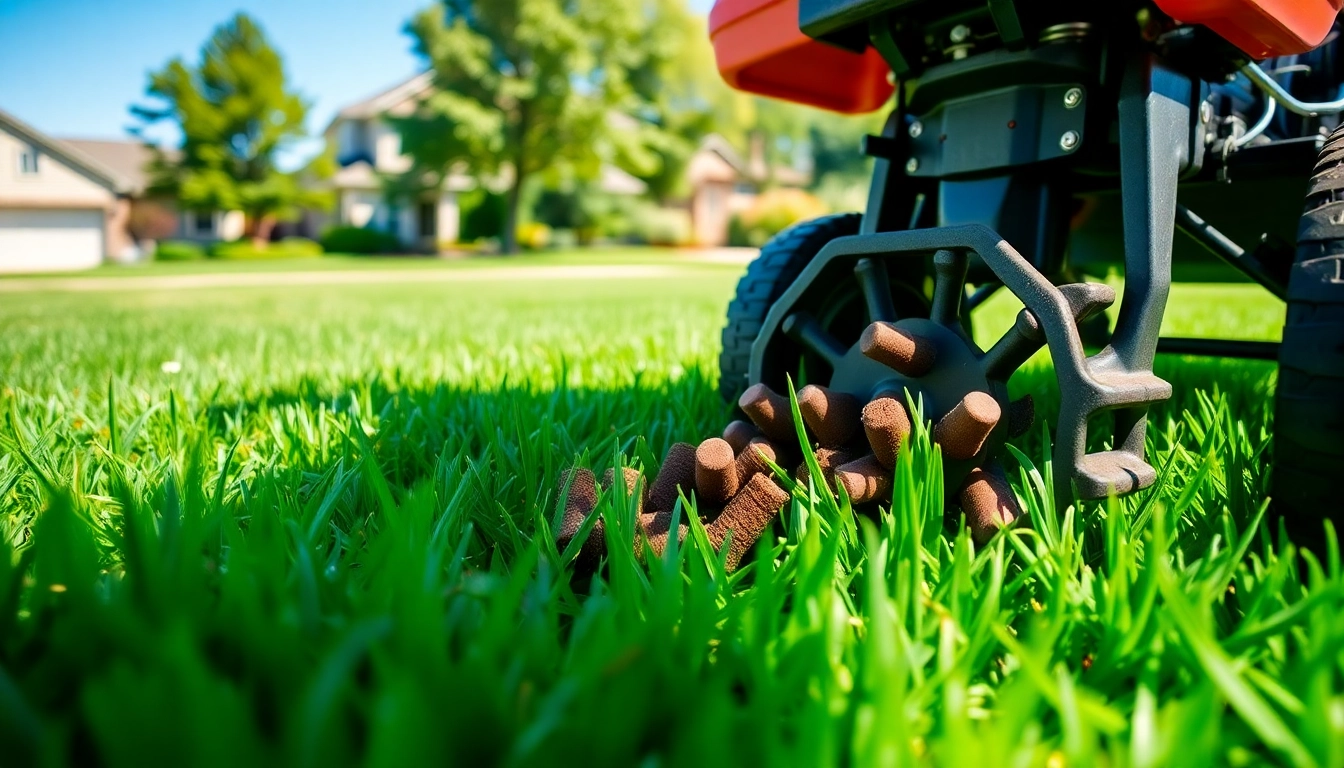
Enhance Your Lawn’s Health Through Effective Core Aeration Techniques
Understanding Core Aeration
What is Core Aeration?
Core aeration is a fundamental lawn care technique involving the removal of small plugs of soil, known as cores, from the lawn. This process enhances airflow, nutrient exchange, and water penetration in the soil, effectively combating compaction. By utilizing a machine called a lawn aerator, which creates holes around ½ to ¾ of an inch in diameter, gardeners reclaim vitality in their lawns. The removed plugs are typically 2 to 4 inches deep and left on the surface to decompose, returning nutrients back to the soil. For those interested in improving their lawn’s health significantly, core aeration is an essential practice.
Benefits of Core Aeration for Your Lawn
Core aeration offers numerous benefits to homeowners looking to maintain or enhance their lawns:
- Reduced Soil Compaction: Aeration helps alleviate the pressure on compacted soil, allowing grassroots to expand freely, which is crucial for robust health.
- Improved Nutrient Uptake: The holes created by core aeration enhance the availability of essential nutrients, enabling your lawn’s grassroots to absorb them more effectively.
- Enhanced Water Penetration: Aeration facilitates better infiltration of water into the soil, ensuring that your grass receives adequate moisture during dry periods.
- Promotes Healthy Growth: The increased airflow reduces stress on the turf, which is particularly beneficial for lawns undergoing heavy foot traffic or environmental stressors.
- Support for Thatch Removal: Core aeration assists in managing thatch by breaking up dense organic material, leading to a more balanced lawn ecosystem.
When to Perform Core Aeration
The timing of core aeration is crucial for its effectiveness. It is generally recommended to aerate your lawn in the early spring or fall, when grass species are in their growth phase. Cool-season grasses typically benefit from spring aeration during their active growth period, while warm-season grasses thrive during the late spring or summer months. Additionally, lawns experiencing heavy foot traffic or dense clay soil should consider annual aeration to maintain optimal health.
Preparing for Core Aeration
Assessing Lawn Conditions
Before executing core aeration, it’s essential to assess the current condition of your lawn. Look for signs of soil compaction, such as bare patches, water pooling, and difficulty in penetrating the soil with a screwdriver. An ideal lawn for aeration should exhibit a high density of healthy grass and minimal evidence of disease or pest issues.
Choosing the Right Equipment
Choosing the right aeration equipment is fundamental to the core aeration process. Homeowners can opt for either manual or powered aerators:
- Manual Aerators: Hand-operated tools may be sufficient for small areas or less compact lawns. Although labor-intensive, they can be effective in the right conditions.
- Powered Aerators: For larger lawns, using a gas-powered or electric aerator is more efficient. These machines can cover more ground quickly, allowing for a more consistent aeration process.
Timing Your Aeration
The best time to aerate often aligns with peak growth periods for grasses. For instance, early spring or fall is generally advisable for cool-season grasses, whereas late spring to early summer suits warm-season varieties. Moreover, checking soil moisture levels can help determine the need for aeration; moist soil provides the best conditions for core removal.
The Core Aeration Process
Step-by-Step Guide to Core Aeration
Performing core aeration effectively involves several key steps:
- Mow the Lawn: Start with a mowing session to minimize grass height, enabling better aeration penetration.
- Water the Lawn: Moistening the soil a day or two before aeration can ease the process of core removal.
- Mark Hazards: Identify underground utilities and other obstacles to avoid damage during aeration.
- Aerate in Overlapping Passes: When using the aerator, create a checkerboard pattern to ensure thorough coverage across the lawn.
- Leave the Plugs: After aeration, allow the removed plugs to decompose naturally back into the soil.
Post-Aeration Care Tips
After core aeration, it’s important to follow some best practices to maximize the benefits:
- Water the Lawn: Ensure your grass receives adequate water for recovery. This helps in reopening soil and stimulates root growth.
- Avoid Heavy Foot Traffic: Minimize foot traffic for a few weeks after aeration to allow the lawn to recover without stress.
- Fertilize: Applying fertilizer after aeration can increase nutrient uptake, helping your lawn regain its strength and vibrancy faster.
- Overseed If Necessary: Consider overseeding after aeration to improve turf density and overall lawn health.
Common Mistakes to Avoid
While aerating, be cautious of several pitfalls:
- Aerating Too Frequently: Excessive aeration can disrupt soil composition and root systems. Most lawns only require aeration once every one to two years, depending on traffic and soil condition.
- Aerating in Dry Conditions: Dry soil makes it hard for aerators to pull cores, leading to ineffective results.
- Working without Planning: Failing to mark hidden obstacles or neglecting pre-aeration mowing can result in damage to the equipment and the lawn.
Advanced Core Aeration Techniques
Combining Core Aeration with Overseeding
Core aeration presents an excellent opportunity for overseeding, which involves sowing grass seeds on bare patches or underperforming areas of your lawn. This combination is particularly effective; the aeration holes provide an ideal environment for seed germination and root establishment. It’s important to select seeds that match your existing grass type and climate conditions for optimal results.
Exploring Liquid Aeration Options
Liquid aeration is a relatively new, less labor-intensive alternative to traditional core aeration. This method involves applying a liquid solution to the lawn that helps to break up compacted soil at a molecular level. While it may not provide the same immediate results as core aeration, it can be beneficial when used as part of a comprehensive lawn care program.
Maintaining Aerated Lawns: Best Practices
Once core aeration has been completed, maintaining healthy grass involves a few key practices:
- Regular Mowing: Keep grass at the appropriate height to promote airflow and prevent disease.
- Consistent Watering: Regularly water to keep roots deep and encourage drought resistance.
- Periodic Fertilization: Use a balanced fertilization schedule to ensure that your lawn receives all necessary nutrients throughout different seasons.
- Monitoring for Pests and Diseases: Conduct regular checks for signs of pest or disease damage, and manage promptly to maintain lawn health.
Measuring the Success of Core Aeration
Signs of a Healthy Lawn Post-Aeration
After conducting aeration, monitor your lawn for positive signs such as:
- Stronger Growth: Noticeably improved growth, especially in areas previously lacking vitality.
- Improved Turf Density: Denser grass coverage indicates successful aeration combined with overseeding.
- Better Color: A richer green color shows enhanced nutrient uptake and overall health.
Using Soil Tests to Assess Improvement
Conducting periodic soil tests can provide insight into the long-term benefits of core aeration. These tests assess pH levels, nutrient content, and soil composition, helping you determine if additional amendments or adjustments are necessary to support ongoing lawn health.
Long-term Lawn Health Strategies
To ensure the longevity of these benefits, establish a holistic lawn care routine. Integrate seasonal maintenance practices, adjust fertilization according to growth stages, and embrace integrated pest management techniques. This approach not only ensures the effectiveness of core aeration but also paves the way for a resilient and vibrant landscape.
